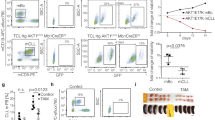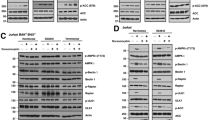Abstract
Kinase inhibitors block proliferative signals in BCR-ABL1+ leukemic cells, but their capacity to induce apoptosis is poorly understood. Initial studies suggested that very brief exposure to kinase inhibitors was sufficient to induce apoptosis in chronic myeloid leukemia (CML) cells. However, flaws in this experimental model have subsequently been identified, leading to the conclusion that apoptosis only occurs with sustained low-level kinase inhibition. Thus, the minimum duration of complete kinase inhibition required to commit CML cells to death is unknown. Here we confirm that <1 h is insufficient to induce significant commitment to death in BCR-ABL1+ cell lines and in primary CD34+ progenitor cells, and establish that commitment to cell death only occurs if kinase inhibition is maintained for 4 h or more. Remarkably, signal transducer and activator of transcription 5 (STAT5) inhibition in combination with transient (<1 h) tyrosine kinase inhibitor (TKI) exposure proved lethal for CML progenitors, despite the reactivation of Bcr-Abl after 1 h. JAK kinase inhibition did not induce cell death in combination with transient TKI exposure. Thus, STAT5 appears to be a critical determinant of the time-dependent sensitivity of CML progenitor cells to TKI treatment in a Bcr-Abl-dependent, but JAK-independent, manner. We conclude that combining kinase inhibition with STAT5 inhibition represents a promising therapeutic approach in BCR-ABL1+ leukemias.
This is a preview of subscription content, access via your institution
Access options
Subscribe to this journal
Receive 12 print issues and online access
$259.00 per year
only $21.58 per issue
Buy this article
- Purchase on Springer Link
- Instant access to full article PDF
Prices may be subject to local taxes which are calculated during checkout







Similar content being viewed by others
References
Deininger MWN, Goldman JM, Melo JV . The molecular biology of chronic myeloid leukemia. Blood 2000; 96: 3343–3356.
Ilaria RL Jr, Van Etten RA . P210 and P190(BCR/ABL) induce the tyrosine phosphorylation and DNA binding activity of multiple specific STAT family members. J Biol Chem 1996; 271: 31704–31710.
Soliera AR, Mariani SA, Audia A, Lidonnici MR, Addya S, Ferrari-Amorotti G et al. Gfi-1 inhibits proliferation and colony formation of p210BCR/ABL-expressing cells via transcriptional repression of STAT 5 and Mcl-1. Leukemia 2012; 26: 1555–1563.
Kok CH, Watkins DB, Leclercq T, D'Andrea RJ, Hughes TP, White DL . Low GFI1 expression in white blood cells of CP-CML patients at diagnosis is strongly associated with subsequent blastic transformation. Leukemia 2014; 27: 1427–1430.
Traer E, MacKenzie R, Snead J, Agarwal A, Eiring AM, O'Hare T et al. Blockade of JAK2-mediated extrinsic survival signals restores sensitivity of CML cells to ABL inhibitors. Leukemia 2011; 26: 1140–1143.
Samanta A, Perazzona B, Chakraborty S, Sun X, Modi H, Bhatia R et al. Janus kinase 2 regulates Bcr-Abl signaling in chronic myeloid leukemia. Leukemia 2011; 25: 463–472.
Yamada O, Ozaki K, Furukawa T, Machida M, Wang YH, Motoji T et al. Activation of STAT5 confers imatinib resistance on leukemic cells through the transcription of TERT and MDR1. Cell Signal 2011; 23: 1119–1127.
Neviani P, Harb JG, Oaks JJ, Santhanam R, Walker CJ, Ellis JJ et al. PP2A-activating drugs selectively eradicate TKI-resistant chronic myeloid leukemic stem cells. J Clin Invest 2013; 123: 4144–4157.
Hantschel O, Warsch W, Eckelhart E, Kaupe I, Grebien F, Wagner K-U et al. BCR-ABL uncouples canonical JAK2-STAT5 signaling in chronic myeloid leukemia. Nat Chem Biol 2012; 8: 285–293.
Hoelbl A, Schuster C, Kovacic B, Zhu B, Wickre M, Hoelzl MA et al. Stat5 is indispensable for the maintenance of Bcr/Abl-positive leukaemia. EMBO Mol Med 2010; 2: 98–110.
Warsch W, Kollmann K, Eckelhart E, Fajmann S, Cerny-Reiterer S, Holbl A et al. High STAT5 levels mediate imatinib resistance and indicate disease progression in chronic myeloid leukemia. Blood 2011; 117: 3409–3420.
Casetti L, Martin-Lannerée S, Najjar I, Plo I, Augé S, Roy L et al. Differential contributions of STAT5A and STAT5B to stress protection and tyrosine kinase inhibitor resistance of chronic myeloid leukemia stem/progenitor cells. Cancer Res 2013; 73: 2052–2058.
Bertolesi GE, Shi C, Elbaum L, Jollimore C, Rozenberg G, Barnes S et al. The Ca(2+) channel antagonists mibefradil and pimozide inhibit cell growth via different cytotoxic mechanisms. Mol Pharmacol 2002; 62: 210–219.
Tecott LH, Kwong LL, Uhr S, Peroutka SJ . Differential modulation of dopamine D2 receptors by chronic haloperidol, nitrendipine, and pimozide. Biol Psychiatry 1986; 21: 1114–1122.
Nelson EA, Walker SR, Weisberg E, Bar-Natan M, Barrett R, Gashin LB et al. The STAT5 inhibitor pimozide decreases survival of chronic myelogenous leukemia cells resistant to kinase inhibitors. Blood 2011; 117: 3421–3429.
Larson RA, Druker BJ, Guilhot F, O'Brien SG, Riviere GJ, Krahnke T et al. Imatinib pharmacokinetics and its correlation with response and safety in chronic-phase chronic myeloid leukemia: a subanalysis of the IRIS study. Blood 2008; 111: 4022–4028.
Picard S, Titier K, Etienne G, Teilhet E, Ducint D, Bernard MA et al. Trough imatinib plasma levels are associated with both cytogenetic and molecular responses to standard-dose imatinib in chronic myeloid leukemia. Blood 2007; 109: 3496–3499.
Brave M, Goodman V, Kaminskas E, Farrell A, Timmer W, Pope S et al. Sprycel for chronic myeloid leukemia and Philadelphia chromosome-positive acute lymphoblastic leukemia resistant to or intolerant of imatinib mesylate. Clin Cancer Res 2008; 14: 352–359.
Talpaz M, Shah NP, Kantarjian H, Donato N, Nicoll J, Paquette R et al. Dasatinib in imatinib-resistant Philadelphia chromosome-positive leukemias. N Engl J Med 2006; 354: 2531–2541.
Kantarjian H, Cortes J, Kim DW, Dorlhiac-Llacer P, Pasquini R, DiPersio J et al. Phase 3 study of dasatinib 140 mg once daily versus 70 mg twice daily in patients with chronic myeloid leukemia in accelerated phase resistant or intolerant to imatinib: 15-month median follow-up. Blood 2009; 113: 6322–6329.
Shah NP, Kasap C, Weier C, Balbas M, Nicoll JM, Bleickardt E et al. Transient potent BCR-ABL inhibition is sufficient to commit chronic myeloid leukemia cells irreversibly to apoptosis. Cancer Cell 2008; 14: 485–493.
Hiwase DK, White DL, Saunders VA, Kumar S, Melo JV, Hughes TP . Short-term intense Bcr-Abl kinase inhibition with nilotinib is adequate to trigger cell death in BCR-ABL(+) cells. Leukemia 2009; 23: 1205–1206.
Snead JL, O'Hare T, Adrian LT, Eide CA, Lange T, Druker BJ et al. Acute dasatinib exposure commits Bcr-Abl-dependent cells to apoptosis. Blood 2009; 114: 3459–3463.
Lipka DB, Wagner MC, Dziadosz M, Schnoder T, Heidel F, Schemionek M et al. Intracellular retention of ABL kinase inhibitors determines commitment to apoptosis in CML cells. PLoS One 2012; 7: e40853.
Wagner MC, Dziadosz M, Melo JV, Heidel F, Fischer T, Lipka DB . Nilotinib shows prolonged intracellular accumulation upon pulse-exposure: a novel mechanism for induction of apoptosis in CML cells. Leukemia 2012; 27: 1567–1570.
Simara P, Stejskal S, Koutna I, Potesil D, Tesarova L, Potesilova M et al. Apoptosis in chronic myeloid leukemia cells transiently treated with imatinib or dasatinib is caused by residual BCR-ABL kinase inhibition. Am J Hematol 2013; 88: 385–393.
O'Hare T, Eide CA, Agarwal A, Adrian LT, Zabriskie MS, Mackenzie RJ et al. Threshold levels of ABL tyrosine kinase inhibitors retained in chronic myeloid leukemia cells define commitment to apoptosis. Cancer Res 2013; 73: 3356–3370.
Hiwase DK, White DL, Powell JA, Saunders VA, Zrim SA, Frede AK et al. Blocking cytokine signaling along with intense Bcr-Abl kinase inhibition induces apoptosis in primary CML progenitors. Leukemia 2010; 24: 771–778.
White D, Saunders V, Lyons AB, Branford S, Grigg A, To LB et al. In vitro sensitivity to imatinib-induced inhibition of ABL kinase activity is predictive of molecular response in patients with de novo CML. Blood 2005; 106: 2520–2526.
Shi JG, Chen X, McGee RF, Landman RR, Emm T, Lo Y et al. The pharmacokinetics, pharmacodynamics, and safety of orally dosed INCB018424 phosphate in healthy volunteers. J Clin Pharmacol 2011; 51: 1644–1654.
Quintás-Cardama A, Vaddi K, Lui P, Manshouri T, Li J, Scherle PA et al. Preclinical characterization of the selective JAK1/2 inhibitor INCB018424: therapeutic implications for the treatment of myeloproliferative neoplasms. Blood 2010; 115: 3109–3117.
DaSilva L, Rui H, Erwin RA, Howard OM, Kirken RA, Malabarba MG et al. Prolactin recruits STAT1, STAT3 and STAT5 independent of conserved receptor tyrosines TYR402, TYR479, TYR515 and TYR580. Mol Cell Endocrinol 1996; 117: 131–140.
Verstovsek S, Kantarjian H, Mesa RA, Pardanani AD, Cortes-Franco J, Thomas DA et al. Safety and efficacy of INCB018424, a JAK1 and JAK2 inhibitor, in myelofibrosis. N Engl J Med 2010; 363: 1117–1127.
Christopher LJ, Cui D, Wu C, Luo R, Manning JA, Bonacorsi SJ et al. Metabolism and disposition of dasatinib after oral administration to humans. Drug Metab Dispos 2008; 36: 1357–1364.
Luo FR, Yang Z, Camuso A, Smykla R, McGlinchey K, Fager K et al. Dasatinib (BMS-354825) Pharmacokinetics and pharmacodynamic biomarkers in animal models predict optimal clinical exposure. Clin Cancer Res 2006; 12: 7180–7186.
Strobl JS, Kirkwood KL, Lantz TK, Lewine MA, Peterson VA, Worley JF 3rd . Inhibition of human breast cancer cell proliferation in tissue culture by the neuroleptic agents pimozide and thioridazine. Cancer Res 1990; 50: 5399–5405.
Hoover RR, Gerlach MJ, Koh EY, Daley GQ . Cooperative and redundant effects of STAT5 and Ras signaling in BCR/ABL transformed hematopoietic cells. Oncogene 2001; 20: 5826–5835.
Warsch W, Grundschober E, Berger A, Gille L, Cerny-Reiterer S, Tigan AS et al. STAT5 triggers BCR-ABL1 mutation by mediating ROS production in chronic myeloid leukaemia. Oncotarget 2012; 3: 1669–1687.
Wang Y, Cai D, Brendel C, Barett C, Erben P, Manley PW et al. Adaptive secretion of granulocyte-macrophage colony-stimulating factor (GM-CSF) mediates imatinib and nilotinib resistance in BCR/ABL+ progenitors via JAK-2/STAT-5 pathway activation. Blood 2007; 109: 2147–2155.
Chen M, Gallipoli P, DeGeer D, Sloma I, Forrest DL, Chan M et al. Targeting primitive chronic myeloid leukemia cells by effective inhibition of a new AHI-1-BCR-ABL-JAK2 complex. J Natl Cancer Inst 2013; 105: 405–423.
Author information
Authors and Affiliations
Corresponding author
Ethics declarations
Competing interests
Nievergall and Hiwase: CSL, research funding, White: Novartis Oncology, honoraria and research funding; BMS, honoraria and research funding; CSL, research funding; Ariad, research funding, Hughes: Novartis Oncology, honoraria, membership on an entity's Board of Directors or advisory committees and research funding; BMS, honoraria, membership on an entity's Board of Directors or advisory committees and research funding; Ariad, honoraria, membership on an entity's Board of Directors or advisory committees.
Additional information
Supplementary Information accompanies this paper on the Leukemia website
Supplementary information
Rights and permissions
About this article
Cite this article
Schafranek, L., Nievergall, E., Powell, J. et al. Sustained inhibition of STAT5, but not JAK2, is essential for TKI-induced cell death in chronic myeloid leukemia. Leukemia 29, 76–85 (2015). https://doi.org/10.1038/leu.2014.156
Received:
Revised:
Accepted:
Published:
Issue Date:
DOI: https://doi.org/10.1038/leu.2014.156
This article is cited by
-
Targeted drug delivery strategies for precision medicines
Nature Reviews Materials (2021)
-
Efficient disruption of bcr-abl gene by CRISPR RNA-guided FokI nucleases depresses the oncogenesis of chronic myeloid leukemia cells
Journal of Experimental & Clinical Cancer Research (2019)
-
The T-cell leukemia-associated ribosomal RPL10 R98S mutation enhances JAK-STAT signaling
Leukemia (2018)
-
Suppressor of cytokine signalling-2 limits IGF1R-mediated regulation of epithelial–mesenchymal transition in lung adenocarcinoma
Cell Death & Disease (2018)
-
Minimal Residual Disease Eradication in CML: Does It Really Matter?
Current Hematologic Malignancy Reports (2017)



